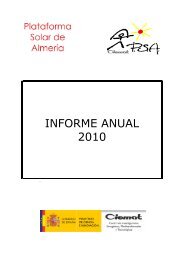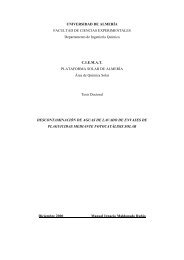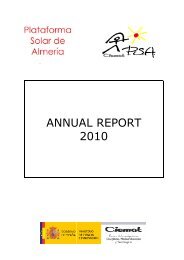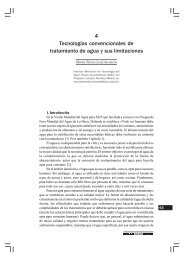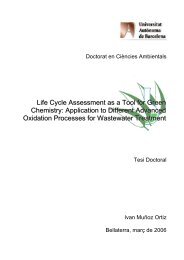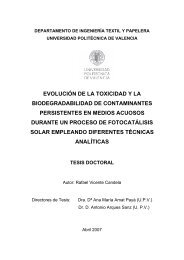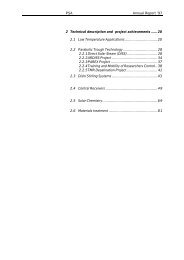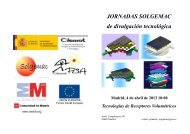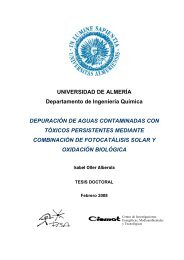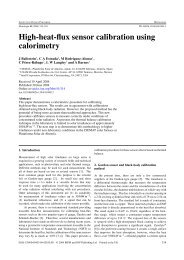Annual Report 2006 - Plataforma Solar de AlmerÃa
Annual Report 2006 - Plataforma Solar de AlmerÃa
Annual Report 2006 - Plataforma Solar de AlmerÃa
Create successful ePaper yourself
Turn your PDF publications into a flip-book with our unique Google optimized e-Paper software.
PLATAFORMA SOLAR DE ALMERÍA<br />
<strong>Solar</strong> gasification of coke without combustion can be represented in a simplified<br />
by the reaction:<br />
⎛x<br />
⎞<br />
CHxOy + ( 1− y)<br />
H2O = ⎜ + 1− y H2<br />
+ CO<br />
2<br />
⎟<br />
⎝ ⎠<br />
(1)<br />
Gasification of 1 mol of C requires approximately 1 mol of C as the source<br />
of energy supply. That is why substitution of fossil energy by solar energy<br />
supply reduces CO 2 emissions by about 50%.<br />
Purpose: The main purpose of the SYPET project is to <strong>de</strong>velop a specific solar<br />
gasification process for coke and waste from extra-heavy oil processing in<br />
the Faja <strong>de</strong>l Orinoco. The <strong>de</strong>velopment is specifically finding the thermodynamic<br />
and kinetic parameters of associated reactions, and selection of particle<br />
sizes and resi<strong>de</strong>nce times, <strong>de</strong>sign of a solar reactor with a quartz window and<br />
its scale-up and testing in a 500 kW installation located at the top of the PSA<br />
CRS tower.<br />
Results achieved in <strong>2006</strong>: After <strong>de</strong>monstrating the technical feasibility of<br />
the process in previous years, in <strong>2006</strong>, testing concentrated on selecting the<br />
optimum coke particle size to be gasified and testing a method of injecting<br />
the material. Finally, it was <strong>de</strong>ci<strong>de</strong>d to feed a slurry of coke particles and water.<br />
The practical advantages of using a slurry are asociated with eaier transport<br />
and injection of the solid reagent and with system scale-up. In <strong>2006</strong>,<br />
experimental testing was done using a petcoke slurry feedstock. Figure 3.23<br />
shows the effect of particle size and stoichiometry of the slurry on chemical<br />
conversion. A higher H 2 O/C in the slurry favors reaction kinetics, but at the<br />
cost of higher flow rates and lower resi<strong>de</strong>nce times, resulting in lower conversion<br />
rates. The mean conversion achieved was 48% and the maximum was<br />
87%, using particles with diameters of less than 80 μm.<br />
The results have served to complete the <strong>de</strong>sign and construct a 500-kW<br />
reactor, as well as for preheating system and heat rejection <strong>de</strong>finition. The<br />
Synpet-500 facility will be erected and tested at the PSA in 2007.<br />
Publication: [3.23][3.24][3.25][3.26][3.27]<br />
Figure 3.23 Chemical conversion of petcoke and energy efficiency of the conversion<br />
in solar tests in or<strong>de</strong>r by particle size and stochiometry of the slurry.<br />
58



